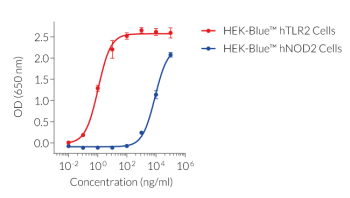Murabutide
-
Cat.code:
tlrl-mbt
- Documents
ABOUT
NOD2 Agonist - Synthetic derivative of muramyldipeptide
Murabutide is a safe synthetic immunomodulator derived from muramyl dipeptide (MDP), the smallest bioactive unit of bacterial peptidoglycan. It was developed as a safe alternative to MDP for use as an immunomodulator after MDP was found to be too toxic to be used as an adjuvant in humans. Murabutide possesses all of the immunomodulatory properties of its parent molecule, MDP, without the associated toxicity [1-4]. Murabutide is recognized by the cytosolic sensor NOD2 [1-2].
Mode of action:
Murabutide exerts its effect through the activation of NOD2. Upon agonist binding, NOD2 oligomerizes and signals via RIP2 kinase. Once activated, RIP2 mediates ubiquitination of NEMO/IKKγ leading to the activation of NF-κB and the production of inflammatory cytokines. Furthermore, poly-ubiquitinated RIP2 recruits TAK1, which leads to IKK complex activation and the activation of MAPKs. This signaling involves the adaptor protein CARD9. It has been reported that murabutide does not transduce the signal through TLR2 or TLR4 [5].
Murabutide induces the activation of NF-κB in HEK-Blue™ NOD2 cells, but no NF-κB was detectable in HEK-Blue™ TLR cells.
Key features:
- Potent NOD2 agonist
- A safe synthetic derivative of MDP
- Each lot is functionally tested
![]() Read our review on NOD-Like Receptors
Read our review on NOD-Like Receptors
References:
1. Rubino S.J. et al., 2013. Identification of a synthetic muramyl peptide derivative with enhanced Nod2 stimulatory capacity. Innate Immun. 19(5):493-503.
2. Jakopin Z., 2013. Murabutide revisited: a review of its pleiotropic biological effects. Curr Med Chem. 20(16):2068-79.
3. Chedid LA. et al., 1982. Biological activity of a new synthetic muramyl peptide adjuvant devoid of pyrogenicity. Infect Immun. 35(2):417-24.
4. Krueger JM. et al., 1984. Muramyl peptides. Variation of somnogenic activity with structure. J Exp Med. 159(1):68-76.
5. Vidal VF. et al., 2001. Macrophage stimulation with Murabutide, an HIV-suppressive muramyl peptide derivative, selectively activates extracellular signal-regulated kinases 1 and 2, C/EBPbeta and STAT1: role of CD14 and Toll-like receptors 2 and 4. Eur J Immunol. 31(7):1962-71.
All products are for research use only, and not for human or veterinary use.
SPECIFICATIONS
Specifications
C23H40N4O11
10 ng/ml - 10 µg/ml
5 mg/ml in water
Activation of NOD2 has been confirmed using HEK-Blue™ NOD2 cells.
Each lot is functionally tested and validated.
CONTENTS
Contents
-
Product:Murabutide
-
Cat code:tlrl-mbt
-
Quantity:5 mg
1.5 ml sterile endotoxin-free water
Shipping & Storage
- Shipping method: Room temperature
- -20°C
- Avoid repeated freeze-thaw cycles
Storage:
Caution:
Details
NOD1 and NOD2
The cytosolic NOD-Like Receptors (NLRs, also known as NODs or NALP) are Nucleotide-binding Oligomerization Domain containing receptors. To date, 22 NLRs have been identified in humans and constitute a major class of intracellular pattern recognition receptors (PRRs) [1].
The founding NLR-family members NOD1 (CARD4) and NOD2 (CARD15) recognize distinct motifs of peptidoglycan (PGN), an essential constituent of the bacterial cell wall. NOD1 senses the D-γ-glutamyl-meso-DAP dipeptide (iE-DAP), which is found in PGN of all Gram-negative and certain Gram-positive bacteria [1, 2] whereas NOD2 recognizes the muramyl dipeptide (MDP) structure found in almost all bacteria. Thus NOD2 acts as a general sensor of PGN and NOD1 is involved in the recognition of a specific subset of bacteria. Both iE-DAP and MDP must be delivered intracellularly either by bacteria that invade the cell or through other cellular uptake mechanisms. Ligand-bound NOD1 and NOD2 oligomerize and signal via the serine/threonine RIP2 kinase through CARD-CARD homophilic interactions [3]. Once activated, RIP2 mediates ubiquitination of NEMO/IKKγ leading to the activation of NF-κB and the production of inflammatory cytokines. Furthermore, poly-ubiquitinated RIP2 recruits TAK1, which leads to IKK complex activation and the activation of MAPKs [4].
Genetic mutations in NOD2 are associated with Crohn’s disease, a chronic inflammatory bowel disease [5]. In addition, numerous studies have recently revealed that NOD1 and NOD2 have a close relationship with a variety of cancers via controlling proliferation, altering immunosurveillance, and interacting with tissue bacteria, including intestinal commensal intestinal microflora. Moreover, additional research into the mechanisms of NOD1 and NOD2 in cancers would shed light on the innate immunity-cancer relationship and provide intriguing targets for immunotherapy [6].
References:
1. Chamaillard M. et al., 2003. An essential role for NOD1 in host recognition of bacterial peptidoglycan containing diaminopimelic acid. Nat. Immunol. 4: 702-707.
2. Girardin S. et al., 2003. Nod1 detects a unique muropeptide from Gram-negative bacterial peptidoglycan. Science 300: 1584-1587.
3. Kobayash, K. et al., 2002. RICK/Rip2/CARDIAK mediates signalling for receptors of the innate and adaptive immune systems. Nature 416: 194-199.
4. Kobayashi K. et al., 2005. Nod2-dependent regulation of innate and adaptive immunity in the intestinal tract. Science 307: 731-734.
5. Ogura Y. et al., 2001. A frameshift mutation in NOD2 associated with susceptibility to Crohn’s disease. Nature 411: 603-606.
6. Wang D., 2022. NOD1 and NOD2 Are Potential Therapeutic Targets for Cancer Immunotherapy. Comput Intell Neurosci.;2022:2271788.
DOCUMENTS
Documents
Safety Data Sheet
Technical Data Sheet
Validation Data Sheet
Certificate of analysis
Need a CoA ?





